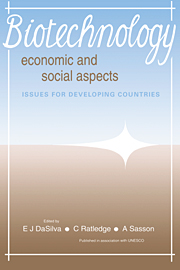Book contents
- Frontmatter
- Contents
- List of contributors
- Preface
- 1 Biotechnology: the socio-economic revolution? A synoptic view of the world status of biotechnology
- 2 Bioethanol production: economic and social considerations in failures and successes
- 3 Biofertilizers: agronomic and environmental impacts and economics
- 4 Microalgal biotechnology: is it an economic success?
- 5 Production of useful biochemicals by higher-plant cell cultures: biotechnological and economic aspects
- 6 Mushroom production – an economic measure in maintenance of food security
- 7 The economic viability of Single Cell Protein (SCP) production in the twenty-first century
- 8 The impact of biotechnology on international commodity trade
- 9 Biotechnology: socio-economic considerations, intercultural perspectives and international viewpoints
- 10 Joint microbial biotechnological ventures in developing countries: social promises and economic considerations
- 11 The economic and social implications of gene technology to developing countries
- 12 Making biotechnology appropriate – and environmentally sound
- 13 Information support for research and development in biotechnological applications
- 14 The effects of emerging biotechnologies on plant and animal agriculture – a viewpoint
- Index
14 - The effects of emerging biotechnologies on plant and animal agriculture – a viewpoint
Published online by Cambridge University Press: 04 August 2010
- Frontmatter
- Contents
- List of contributors
- Preface
- 1 Biotechnology: the socio-economic revolution? A synoptic view of the world status of biotechnology
- 2 Bioethanol production: economic and social considerations in failures and successes
- 3 Biofertilizers: agronomic and environmental impacts and economics
- 4 Microalgal biotechnology: is it an economic success?
- 5 Production of useful biochemicals by higher-plant cell cultures: biotechnological and economic aspects
- 6 Mushroom production – an economic measure in maintenance of food security
- 7 The economic viability of Single Cell Protein (SCP) production in the twenty-first century
- 8 The impact of biotechnology on international commodity trade
- 9 Biotechnology: socio-economic considerations, intercultural perspectives and international viewpoints
- 10 Joint microbial biotechnological ventures in developing countries: social promises and economic considerations
- 11 The economic and social implications of gene technology to developing countries
- 12 Making biotechnology appropriate – and environmentally sound
- 13 Information support for research and development in biotechnological applications
- 14 The effects of emerging biotechnologies on plant and animal agriculture – a viewpoint
- Index
Summary
Introduction
The development and adoption of new agricultural technologies have made North American agricultural producers and processors among the most productive in the world. As a result, North American households spend a smaller percentage of their income on food than households in other countries. However, concern has been expressed about whether the record of increasing productivity gains in agriculture can be sustained. The mechanization of agriculture is now virtually complete, and the use of chemical inputs developed for agriculture following World War II is widespread. Fortunately, scientists agree that another major technological revolution has started – a biotechnology revolution. It is argued that biotechnology has the potential to allow some countries in Europe and the United States to increase their industrial and agricultural productivity and hence maintain their competitiveness in world markets.
Biotechnology has two characteristics that are significantly different from previous agricultural technologies. First, biotechnology can be used to enhance product quality by improving characteristics of plants or animals. Second, biotechnology has the potential for conserving natural resources and improving environmental quality by use of genetically engineered organisms for degradation of toxic chemicals in the environment and by the development of insect and disease resistant plant varieties.
Current status and prospects of agricultural biotechnology
Biotechnology has its roots in agriculture and presents important opportunities for mankind. Powerful tools have been created to carry out the purpose of agriculture, i.e. to use intelligently natural resources for the production of more and better food and fibre products. The tools of biotechnology differ from traditional methods primarily in their speed, precision and reliability.
- Type
- Chapter
- Information
- Biotechnology: Economic and Social AspectsIssues for Developing Countries, pp. 354 - 368Publisher: Cambridge University PressPrint publication year: 1992
- 1
- Cited by

